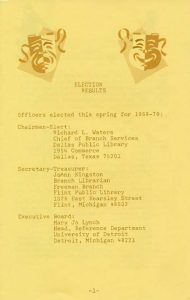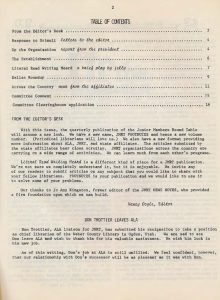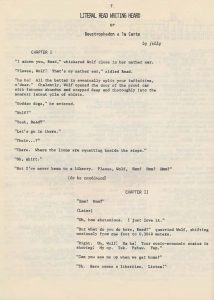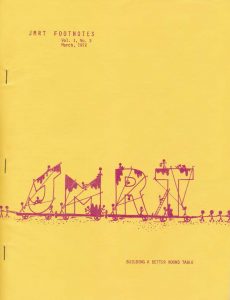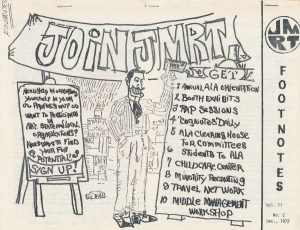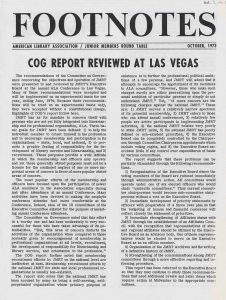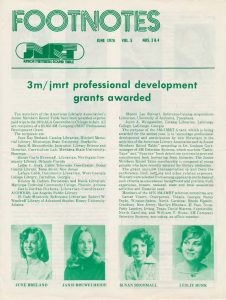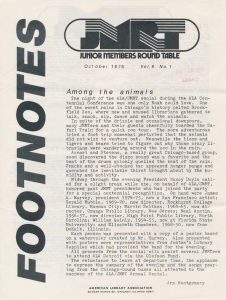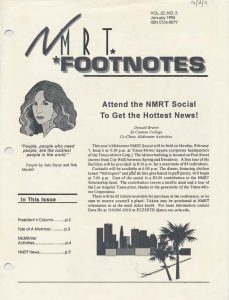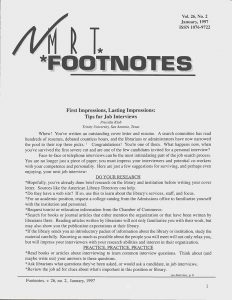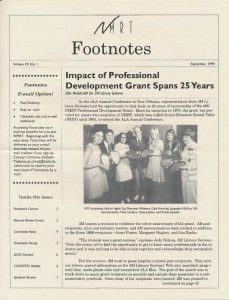Since 1971, or 1966 if you include the predecessor publication News Notes (1966-1971), the New Members Round Table has published Footnotes as an information resource for new professionals. During the last fifty years, many ALA members have contributed great amounts of energy and creativity to support new ALA members. Most editors served for two volumes, resulting in a rich tradition of continuous but ever-changing layout and content for all readers to enjoy.
Read on to learn more about the art and history of Footnotes!
News Notes, 1966-1971
Editor Jean Meadows Lucas, then Purdue University Librarian (1964-68), led the development of News Notes’s first volume. Each issue included a letter from the Chair, letters to the Editor, announcements from different chapters, and advertisements for Round Table member events.
For the second volume, JoAnn Kingston, then at Flint Public Library Freeman Branch, became editor and the layout changed to include color paper, a new logo, contact information for officers, and announcements for pre-conference institutes. It was the third volume of New Notes which set the tone for future issues. First, more general information about the ALA was included. A new section called “ALA Profile” provided administrative summaries and histories of different ALA agencies and divisions, to help new members become familiar with the organization. Then, in the second issue, the first clip art images were used between articles. Over time, these whimsical images increased in frequency and in use throughout future issues.
In the images above, Volume 3 includes a few images which complement the textual information. While some uses were non-sequitur, like in Volume 3, Number 3, where the cat has no thematic connection with the text, the second example in Number 4, humorously frames the theme of Round Table officer elections results as tragedy and comedy. In Volume 4, the images are referenced in the text, as seen in the comparison of Midwinter in Chicago with a tropical beach and talking dog who endorses attending the upcoming conference. Later that year, News Notes was replaced by Footnotes but the original artwork would continue.
A research tip: to learn more about early career librarians’ views on the history, current status, and future of the profession, researchers should include reading the letters to the editor.
Footnotes, 1971-2015
During the second half of 1971, News Notes was replaced with Footnotes but much of the previous energy and innovations continued. In just the first volume alone, there were creative writing submissions, a variety of cover art, and even an experimental insert to include photos of members without interfering with the Midwinter Report text.
The second volume featured comparably bold layout experimentation, including more unique cover artwork selections and an innovative program to help new professionals find lodging or other support while traveling to the 1973 Midwinter Conference. In the images below, the cover of Number 2 humorously offers a money-back guarantee to new members who are disappointed with membership and the cover of Number 4 symbolically signifies the end of the year and the beginning of the new year with the Ace of Spades.
The third volume featured a new layout two columns of text on every page and even the cover included articles. The new Editor was Bridget L. Lamont of the Illinois State Library. Volumes 3, 4, and 5 maintained the new layout while gradually reincorporating images and colored text, as seen in the images below. A new Junior Members Round Table logo was included in Volume 5 too.
Under Editor Ann Scott, then of Virginia Beach Public Library, the sixth and seventh volumes featured a return of earlier unique cover artwork for each issue. The earlier humorous use of images returned too.
Under Paula A. Murphy, then of Governors State University’s Learning Resource Center, the eighth and ninth volumes continued the humor with a variety of typefaces used throughout the issues.
A research tip: Researchers should be sure to examine the use of images and humor throughout the issues beyond the cover pages, to further explore the interests and creativity activity of new professionals.
The tenth and eleventh volumes, under Editor Kevin M. Rosswurm, then of Akron-Summit County Public Library, replaced the cover art with original articles about professional development.
The twelfth and thirteenth volumes, under Editor Pat Naismith, then of Free library of Philadelphia, used the cover as a space for either JMRT presidential messages or for announcements regarding upcoming conferences.
The fourteenth and fifteenth volumes, under Editor Lorretta J. Turnage, then of National Library of Medicine, included biographies of JMRT officer nominees as well as a bibliography of library and related careers.
The sixteenth, seventeenth, and eighteenth volumes, under Editor Sharman E. Prouty, then of Historic Deerfield Library, Massachusetts, continued the trend of previous editors and expanded the annual color scheme of holiday issues. Previously, under the monochrome ink scheme, it was Editor Turnage who added red ink highlights to the winter issues. Under Editor Prouty, the entire winter issue used red and green colors throughout the entire issue. Lorretta Turnage returned as a special guest editor for the final issue of Volume Eighteen, when the designated new editor resigned and was replaced by a different editor. In the images below, the gradual introduction of color and decoration has affected the appearance of standard issues and winter holiday issues.
The nineteenth and twentieth volumes, under Editor Rachel H. Robbins, then of Sterling C. Evans Library, saw the renaming of JMRT to New Members Round Table (NMRT), and the reintroduction of humorous clip art paired with witty captions and text.
The twenty-first and twenty-second volumes, under Editor Darlene Nicholas, then of the University of Michigan Social Work Library, included feature articles on professional development and stated deadline dates for issue content submissions too. The twenty-second volume was the first volume to be printed on recycled paper too.
The twenty-third and twenty-fourth volumes, under Editor Marilynn Green, then of University of Houston Libraries, included unique images in every issue.
During the early 1990s, the publication returned to a consistent black ink schema but the humorous clip art tradition continued. By the late 1990s, Footnotes was available via email which increased the potential access and circulation of issues to subscribes. Then, beginning in January 2016, the quarterly electronic publication of the Footnotes newsletter was replaced by the use of the NMRT Blog (http://www.nmrt.ala.org/notes/), the official blog for the New Members Round Table.
Copies Available at Your ALA Archives
Physical copies of NEWS NOTES and FOOTNOTES are available for viewing at the ALA Archives; however, not all copies are available yet. Please view the Record Series 46/2/11 database record entry, for information on which issues you can view or donate.
Got Something to Donate to the Story So Far?
Behind the headlines has stood a skilled volunteer crew and current ALA Archives holdings do not include all of those names. Were you (or somebody you know) a member of NEWS NOTES or FOOTNOTES? We welcome you to share your part of ALA history in the comments or to contact us. We and our readers would like to hear from you.






